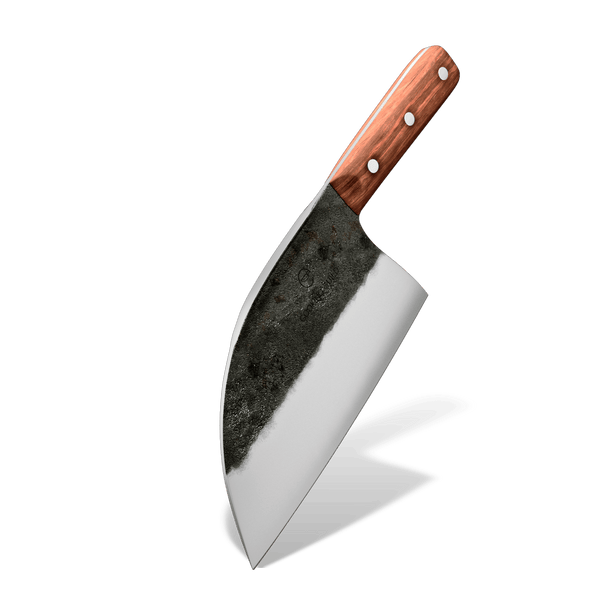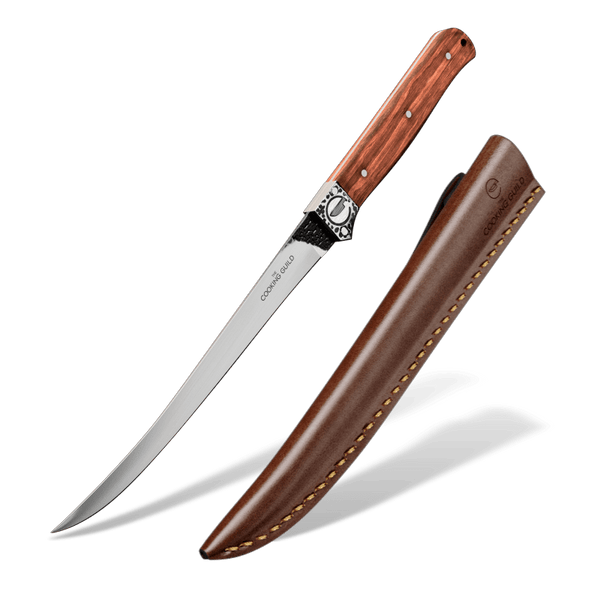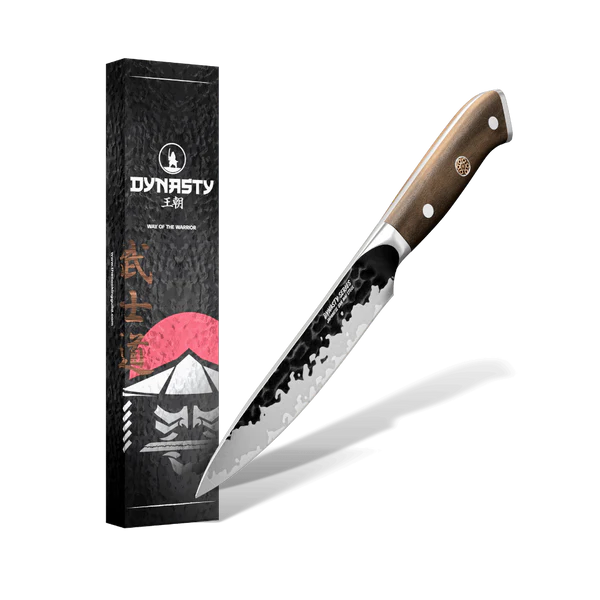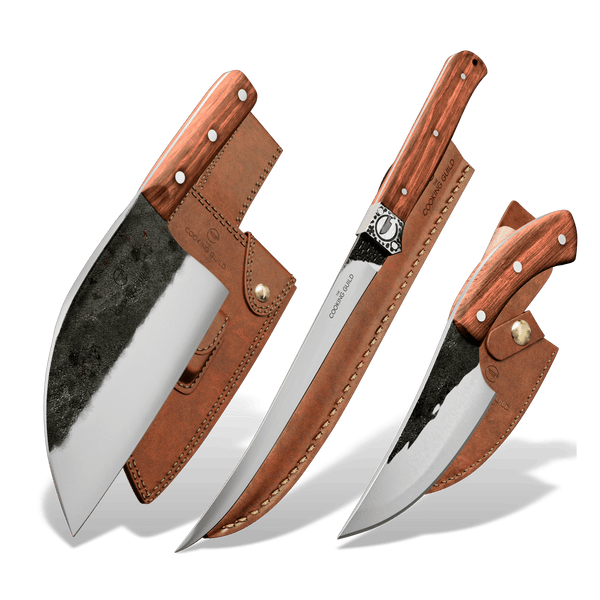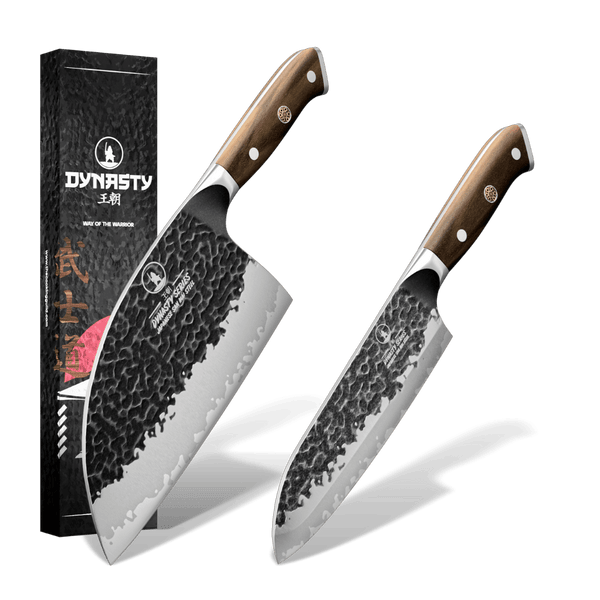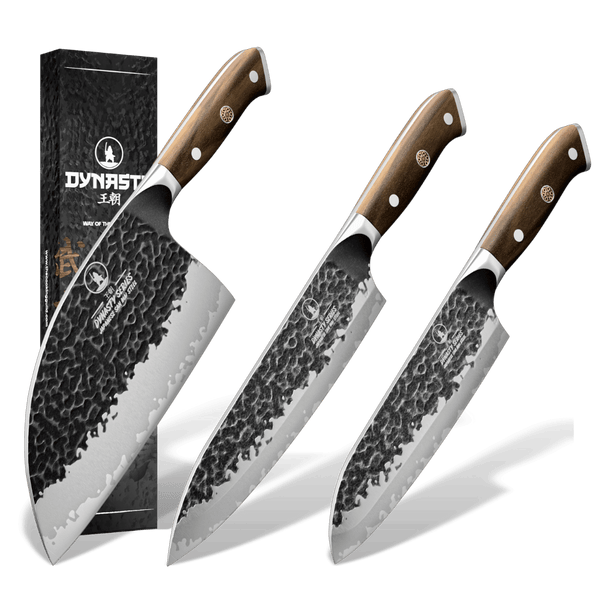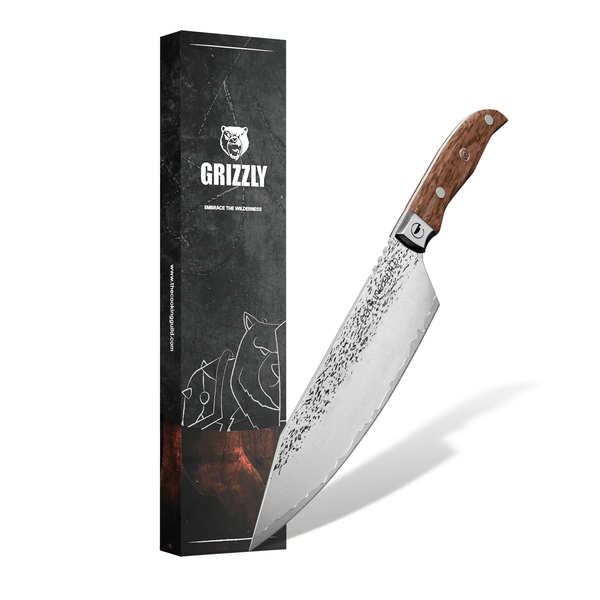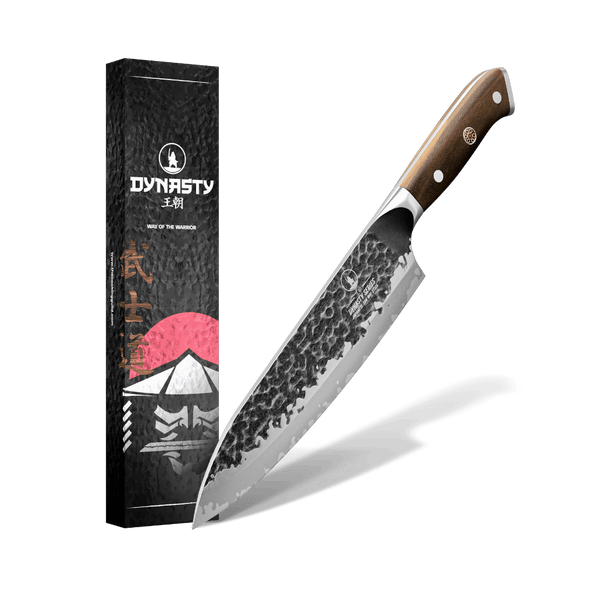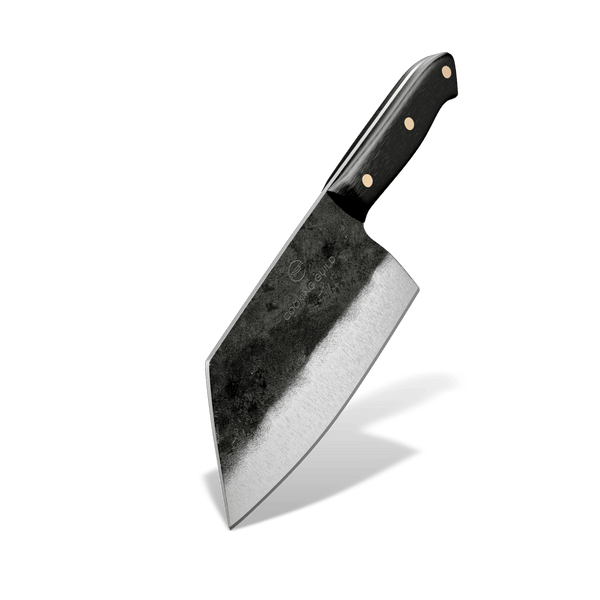In the labyrinth of metallurgy, Damascus steel emerges as a legendary and distinctive material, its reputation forged in the fiery crucibles of ancient blacksmiths. This steel, characterized by its unique wavy or “watered” pattern, has been surrounded by myths and allure since its conception in India around 300 B.C., subsequently named after Damascus, the Syrian city where it gained considerable fame.
Revered by warriors and weapon enthusiasts for its reputed resilience, flexibility, and sharpness, Damascus steel is commonly associated with some of the finest swords in history. But does its historical acclaim align with actual material performance, or is it shrouded in tales of the bygone?
In this blog, we will unravel the secrets behind Damascus steel, exploring its properties, applications, and whether its celebrated characteristics stand up to modern scientific scrutiny. We will dissect the tales, uncover the truths, and determine objectively if Damascus Steel truly lives up to its illustrious reputation.
Damascus Knife: The Complete Guide
For a long time, chefs, blacksmith enthusiasts, and many historians have considered Damascus steel as a prevalent and high-performing material. These types of steel were used in a wide range of weapons in the past, which are slowly adopted into today's kitchen knives.
In today's market, Damascus knives are highly regarded as special knives with the finest qualities in providing equally high-quality performances. These steel have a rich history with origins from people like the Japanese and a background that only offers more credibility as a unique historical type of steel and forging method. Take a deep dive and uncover the culture, history, and preset preferences that favor Damascus steel as components for today's kitchen knives.
What Is Damascus Steel?
From the general point of view, Damascus steel refers to the type of steel and the forging method used in creating these metal components. This type of steel is popularly known for having wavy artistic patterns within the side of the sharp edge blade upon finalized results. These metals have high strength, exceptional sharpness, and durability. The unique visual design of these types of knives is created through pattern welding.
The type of forging revolves around layering and folding various layers of different types of steel of carbon varieties and repeating this folding process. This would create a distinctive pattern which varies on which specific techniques are used.
Cast Damascus Steel
Cast Damascus Steel is the modern approach to replicating the traditional appearance of Damascus steel by using casting methods. Traditional forging methods have been lost throughout history and have yet to be found.
By today's standards, the process of making modern Damascus steel revolves around mixing different types of steel alloys and carbon contents to create the desired visual pattern. While Cast Damascus can replicate the aesthetic appeal of traditional Damascus, it only partially replicates the same structural characteristics and quality. That is not to say that this type of steel is also strong and resilient in its own right.
How Damascus Steel Got Its Name
The name "Damascus Steel" has been derived from the Capital city of Syria, Damascus. Numerous historical records have concluded the Syrian capital to be the place and origin of the first Damascus steel blades and forging techniques.
The name translates to "well-watered land" and has gained prominence during the Middle Ages.

The History Of Pattern Welded Damascus Steel
The history of Damascus Steel dates is rich and deep, dating back to over 1500 BC. Numerous records have dated that the origin of both the steel and forging method is found within the Middle East. Bladesmiths within the region have adopted the unique approach of layering varying steels and iron together. This resulted in the unique pattern and substantial blade the majority of people know today.
Over time, the knowledge of making Damascus Steel spread beyond the Middle East; other regions, such as India and Europe, have made their attempts to make their steel.
Pattern Welded Steel As The Wootz Alternative
Pattern-welded steel has a history and characteristics that make it stand out as an alternative to Wootz Steel. These types of steel are developed in various regions, such as Europe and Japan, and follow the tradition of layering and forge-welding different steel and iron. Wootz Steel is famous for its quality and is located around India. These types of steel are equivalent to Damascus Steel due to their similar forging and exceptional quality results.
Pattern Welded Damascus Restarted With Guns Then Moved To Knives
The art of forging Damascus patterns and steel is renowned for its creative quality and exceptional perks of strength, durability, and sharpness. These forging techniques were used in crafting swords and blades in the past.
This art form slowly faded into obscurity, given the sudden rise and evolution of firearms. The continuous influence and changes firearms brought at the time have slowly made swords and knives less relevant.
However, this form of forging has slowly changed from blades to gun frames. These forgings have been adopted into crafting metal gun parts for customized orders. Over time, modern iterations of Damascus Steel have now been implemented through modern kitchen knives.
What Is Modern Damascus Steel Usually Made Of
By today's standards, pattern-welded steel has been considered as being close to being today's modern Damascus steel. This modern iteration of the mythical steel usually consists of a combination of two or more types of high-carbon steel. These two types of steel are commonly used due to their contrasting properties. This allows the finalized product to exhibit a remarkable and balanced quality of hardness and toughness.
How Damascus Knives Are Made
Damascus Steel doesn't just refer to the steel itself; it is also the name of the forging style in making this type of steel. Both the traditional and modern iterations of these blades have been made through the same method and process. This aforementioned process begins with blacksmiths or knife makers selecting different high-quality steel and forging them together. Afterward, the forgers would hammer the heated metal and fold it over multiple times before shaping it into their desired shape.
The result of these repeating folding, hammering, and forging would result in a blade that possesses unique patterns, a traditional sign of any Damascus creation. The blade will undergo heating treatment and then rapidly be cooled in water or special oil afterward. Upon being polished, the Damascus pattern hidden within the steel will be revealed into the sides of the blade.

Types Of Damascus Steel
Currently, two primary types of Damascus Steel are put on record:
Pattern-Welded Damascus
Pattern-welded Damascus is the ancient iteration of this steel. Pattern-welded Damascus is known for its unique wavy or artistic patterns. This is usually done by welding together different layers of varying steel.
Modern Damascus
Modern Damascus is the more contemporary interpretation of the traditional technique. In comparison, this type of steel may only partially mimic the elaborate patterns of its ancient predecessor. However, this modern take makes up for its creative patterns and combines both the traditional approach with modern materials.
Choosing Steel For A Damascus Blade
When it comes to forging Damascus steel, it is very important to choose the right type of metal for its components. As aforementioned, these types of steel are well renowned for possessing striking patterns and vital metal components for any bladed weaponry or cutlery.
High-carbon steels are highly preferred because they provide both hardness and edge retention. Additionally, low-carbon steels are also provided due to these types offering flexibility. This flexibility is essential as this factor helps create the signature wavy patterns.
Other alloy elements such as nickel, manganese, and chromium serve as additional enhancements towards the finished blade. The choice of alloys also aligns with the desired characteristics and aesthetics of the final blade.
Is Damascus Steel Strong?
Damascus Steel has been historically depicted to be a strong and durable steel, which is commonly implemented in all sorts of weapons and tools. Its unique forging method of using layering and folding processes helps create a hard and flexible material.
Not All Damascus Is Created Equal
While it is highly regarded for its strength and resilience, it is important to note that not all Damascus Steel is made of the same quality. The quality and performance overall depend on several factors. These would include how well the bladesmith forged the metal and the type of steel that is used. Generally, blacksmiths with years of experience have careful approaches and selections to achieve the desired balance between strength and flexibility.
Factors Affecting Damascus Steel Quality
Several factors can affect the quality of Damascus Steel. To forge these steels, blacksmiths have deep knowledge regarding these factors and techniques over time. These include:
- Steel Composition: This revolves around the type of steel alloys that are used in the final composition. The selection of what type of steel is crucial in making a high-quality Damascus.
- Craftsmanship: Experience tells the story. A combination of in-depth skills and long experience are needed to undergo the meticulous methods of Damascus forging processes.
- Heat Treatment: Precise temperature control, quenching, and tempering are essential steps in forging high-quality steel. Proper heat treatment can greatly affect the steel's overall quality.
- Pattern Consistency: The forging process and heat treatment are two important phases affecting the signature patterns' consistency.
- Alloy Purity: Alloy impurity also plays a part in affecting the steel's quality. Any potential impurities can weaken the steel's structure and integrity.
The Advantage Of Damascus Steel As A Knife
There are several key advantages of forging a chef knife using Damascus Steel as its main component. One of the key advantages is the remarkable sharpness and edge retention the steel offers. This type of steel offers great quality. Another advantage this steel offers is the natural durability of its components. Knives made under this component are made to be tough and resistant. Additionally, Damascus knives are corrosion-resistant.

Differences Between Damascus Knives Vs. Carbon Steel Knives
Damascus knives and Carbon steel knives are both made with high quality and offer great culinary performance. Both types of blades are used in many professional kitchens due to their long-lasting strength and durability in prolonged uses. These knives perform excellent cutting quality and are durable for continuous use.
However, both knives are still uniquely different from one another. Each difference helps both blades stand out from one another.
Carbon Steel Knives
Carbon steel knives are sharp edge blades that are famously known for their ease of sharpening. They are primarily made of iron and carbon. This makes them less resistant to staining and corrosion. These sets of knives require more maintenance to prevent rusting and discoloration.
Damascus Steel Knives
Damascus steel knives Damascus steel knives are popular among chefs and collectors due to the steel's unique intricate pattern. These knives are very sharp thanks to the complex layering and processes this steel has undergone. These knives are both visually stunning and high-performing; they aim to rediscover the alloy compositions and heat-treatment plan results in the high-quality steel in question.
It's A Matter Of Choice
Choosing between Damascus and carbon steel knives depends highly on individual preferences and uses. Damascus knives are extremely popular for their sharpness, resilience, and uniquely forged patterns. Carbon steel knives are ideal for simpler uses and for those looking for extra maintenance features.
Differences Between Damascus Steel Knives Vs. Stainless Steel Knives
In contrast to carbon steel knives, stainless steel knives, and Damascus knives are very greatly different in numerous ways. Firstly, Damascus knives, as aforementioned, are beloved for their distinctive patterns and exceptional sharpness. They are very durable knives that resist chipping and damage on prolonged use. These knives are a popular selection among chefs.
In contrast, stainless steel knives are highly corrosion-resistant and are made of iron and other elements. They sacrifice sharpness and performance when compared to Damascus or carbon steel knives.
What Is Stainless Steel?
Stainless steel is a type of alloy that possesses around 10-12% chromium content. Stainless steel is highly invulnerable to rust and staining. Additionally, these steel are used in various applications such as cutlery, making them popular options for mass-produced cutlery.
So, Which Is Best?
Individual preferences are needed when it comes to finding which type of steel is best suited. For high performance, excellent sharpness, and longevity, Damascus knives are highly sought after for these perks. In comparison, stainless steel knives are good options for those looking for budget-friendly options and little maintenance.

What Makes That Attractive Pattern?
The patterns that are usually seen in Damascus Steel come from the unique forging process in making this steel. These steel types are made by layering and folding multiple types of steel laters together, which are forged and physically heated, folded, and hammered repeatedly. These patterns emerge after the steel is etched or treated, depending on the bladesmith, different techniques can be used to create the initial pattern.
The Various Patterns Of Damascus
Damascus Steel has different ranges of pattern styles. They are usually revealed during the finalization of the steel. These patterns can be different in appearance depending on what pattern the blacksmith is looking for.
There are common types of patterns, such as:
- Raindrop Pattern: This type of pattern resembles small, circular shapes that resemble raindrops on a water surface.
- Wave Pattern: This pattern resembles flowing waters or extremely wavy patterns that resemble liquid. This is considered by many craftsmen to be one of the most common patterns.
- Latter Pattern: This pattern resembles parallel lines or ladder-like formations.
Other unique patterns surfaced over time, these include:
- Feathered Pattern: This unique pattern resembles sharp avian feather-like formations.
- Sharktooth Pattern: As the name implies, this type of pattern heavily sets formations that resemble layers of shark-like teeth or arrowhead tips.
- Diamondback Pattern: One of the rarer patterns, this takes the form of diamond-equal shape formations within the blade.
Pattern-welded And San-mai Damascus Steel
Pattern-welded steel and San-Mai steel are defined as two distinct techniques in forging results that are equivalent to Damascus steel. However, both metals possess their unique characteristics. Pattern-welded steel is crafted using the layering and folding method. Like Damascus, this steel will result in a visually striking patterned steel. This steel's artistic appearance and performance make it highly valuable to chefs and collectors.
While San-mai steel is constructed using the core of carbon steel with multiple softer, more resilient steel. This results in the San-mai possessing superior edge-holding capabilities despite lacking unique patterns.
Damascus Knife Recommendations
Here are a few recommendations for individuals looking for what type of Damascus knife they will need in their utility.

Chef's Knife
A chef's knife is the most common tool among kitchen utensils. They are usually broad, sharp blades that are made to be versatile in any slicing and cutting tasks.
Utility Knife
Compared with a chef's knife, a utility knife is made smaller for multiple purposes. This is ideal for simple tasks such as slicing sandwiches and trimming fruits and vegetables.
Meat Knife
Meat knives, as they are named, are specialized in cutting meat. This knife typically features a long, narrow blade for precise slicing and carving features.
Paring Knife
A paring knife is a small, versatile tool often used for intricate tasks such as precise cutting and trimming.
Cleaver Knife
A cleaver is known for their heavy build. Cleavers are designed for chopping bones and tough cuts of meat. A Damascus-made cleaver results in quality strength and sharpness.
What To Look For When Shopping For A Damascus Knife
When it comes to looking for a Damascus knife, numerous factors need to be considered to ensure investments in quality knives are worth it. It's essential to understand what these steels are made of. This ensures that high-quality materials are used in making Damascus knives. This also goes the same with the blade's hardness and the budget costs for each blade.
Which Damascus Steel Is The "Real" One
Determining authentic Damascus steel can be challenging due to its deep history and reputation for high quality and performance. In a deeper context, modern Damascus knives are made to replicate the unique patterns the "real" Damascus provides. Several marketplaces advertise providing real "Damascus" knives. However, this is only on the surface instead of the components.
How To Spot A Fake Damascus Knife
To distinguish a fake Damascus knife from a real one, it is essential to look into the appearance first. Many fake Damascus only use artificial-looking patterns, while authentic Damascus blades are forged from the inside to the outside.
Beware Cheap Damascus
Authentic Damascus knives are also a bit pricey. Replicated Damascus knives are often too cheap in terms of budget and pricing. On paper, extremely cheap knives result in poor quality and performance. Copycat knives are also dull, making them more dangerous to use.

How To Care For Damascus Steel
Taking care of your Damascus Steel knife comes with needed attention and care. Several methods and steps need to be followed to properly take care of your Damascus knives. Firstly, Damascus knives need to be washed using clean water and soap to prevent oil and other contents from staining the blade. After washing the blade, wipe the blade properly with a dry cloth and lubricate it using the provided oil.
Treat Your Damascus Correctly
When it is in use, you need to properly hold and wield the knife while cooking. It is important to know what the knife is built for and not use it for other means, such as chopping through extremely dense bones.
What Is Wootz Damascus
Wootz Damascus, or simply Wootz Steel, is another alternative to Damascus Steel. These types of steel originate from India and are comparable in pattern appearance and quality. This type of steel is the predecessor of Damascus Steel.
Crucible Steel From Other Places, Maybe
Damascus Steel has become an influential factor in forging. The type of forging this steel uses is replicated in many regions, such as India and Europe. These are attempts at making strong metal components for weapons.
How Did Wootz Steel Become Damascus Steel
The transformation from Wootz Steel into Damascus Steel can be traced back to India. Renowned for its unique composition, strength, and sharpness quality have been adopted into the city of Syria, where blacksmiths have made their approaches in perfecting the forging process.
The Source Of The Water Pattern
The iconic water-like pattern found on Damascus blades comes from the unique forging method that involves the process of heating, folding, and hammering on repeated pacing. These patterns would surface after the finalized steel is treated under special oil or acid.
Modern Wootz Steel Is Kind Of A Thing
In recent years, there has been a sudden rise in interest in recreating this steel. Modern blacksmiths and craftsmen have been experimenting with different approaches.
Wootz Damascus, Pattern Welded Damascus, And Solid Steel: Which Is Better
Wootz Damascus, Pattern welded Damascus, and solid steel are common components that are made using high-quality performing knives. Despite their common uses and dependency on steel materials, they all have their unique characteristics.
Wootz Damascus Vs. Modern Solid Steel
While it is renowned for its legendary sharpness and exquisite damask patterns, Wootz Damascus is considered limited by issues of complexities in terms of large-scale production. Solid steel offers uniformity, durability, and a wide array of alloy choices. However, the limit comes that solid steel has little to no creative patterns within.
Pattern Weld Damascus Vs. Modern Solid Steel
Pattern-welded Damascus is highly regarded for its captivating aesthetics, characterized by intricate patterns formed through the layering of diverse steel types. It results in visually striking creations, although it may not always match the performance of modern solid steel in terms of strength and endurance.
In contrast, modern solid steel provides enhanced control over composition and hardness, rendering it a more dependable option for specific applications, particularly when performance is of paramount importance.
Wootz Steel Was Impressive For Its Time
This type of steel earned admiration for its sharpness and robustness, establishing itself as a valuable material for weapons and tools. The distinctive manufacturing process involving crucible smelting and precise cooling created unique patterns that fascinated many.
Nonetheless, the limitations in terms of production consistency and the challenges associated with expanding production prevented it from fully satisfying the demands of contemporary industry.
Other Stuff You Could Maybe Learn
For more details about the science behind knife-making and insightful coverage regarding Damascus Steel, we highly recommend Larrin Thoma's book, "Knife Engineering: Steel, Heat Treating, and Geometry." As well as John Verhoeven's book, "Damascus Steel Swords: Solving the Mystery of How to Make Them."
FAQs
Here are some common FAQs regarding Damascus knives.
What Is Special About Damascus Knives?
Damascus knives are popularly known to possess excellent sharpness, the strength of their constitution, and uniquely designed patterns. Additionally, the forging methods used in making Damascus knives are intricate and involve a lot of processes.
What Is A Damascus Knife Worth?
An authentic and quality-designed knife's lower estimates range between $100 to $500 in US Dollars.
Is Damascus Good For Knives?
Damascus Steel is highly regarded as a perfect material for knife-making. These steel are perfect due to their composition and aesthetic appeal.
Is Damascus Steel Better Than Regular Steel?
While it is not entirely better than regular steel, Damascus excels in factors such as artistry, appeal, quality, and uniqueness.
Is Damascus Steel Still The Best?
It is not universally accepted as the best there is. Damascus Steel has a rich history and is tailored for specific purposes, making them extremely valuable resources.
What Are The Disadvantages Of Damascus Steel?
Damascus Steel has several disadvantages, such as exposure to corrosion and weakness to rust. Additionally, they are more expensive and require careful maintenance.
